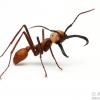Solenopsis invicta pretty much has a 100% success rate. Super easy. They were my first successful species I've had.
Solenopsis aurea/amblychila and xyloni all have a near 100% success rate as well.
Pogonomyrmex californicus (the ones along the coast), they always die on me. Pogonomyrmex californicus out in the desert have a near 100% success rate (the bi-color wasp-like ones). The ones along the coast are like frail pansies, probably not really even the same species. But that is a different topic.
Most of the desert ants have a much higher success rate in general, than ones found along the coast or mountains. Probably because they are a lot hardier from living in a harsh environment. I have a MUCH better success with desert ants than any other ant from other climates. With a few exceptions like Solenopsis invicta (which are more tropical/temperate climate I believe) and Pheidole megacephala (which are super easy and they are more of a tropical ant as well).
On the other hand, ants I find in the mountains have a vastly lower success rate for me. Takes a lot more queens to get a good colony out of mountain ants, and never yet had an actual successful ant colony that I've found in the high altitude mountains.
![]() !)
!) 






















